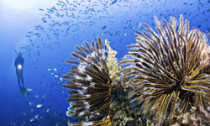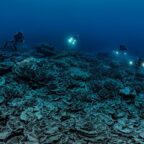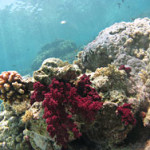
Scientists have tested a surprisingly cheap and effective way to assess the health of vulnerable coral reefs and to monitor threats on remote atolls: eavesdropping.
In a study, published Aug. 6, 2015 in Marine Ecology Progress Series, scientists at Woods Hole Oceanographic Institution (WHOI) used low-cost autonomous underwater recorders over four months to collect “soundscapes” of reefs in in the U.S. Virgin Islands. They showed how the collective sound recordings of reef inhabitants painted vivid pictures of the reefs’ abundance and diversity.
In a second study, published the same day in Marine Pollution Bulletin, the researchers recorded boat noise — showing how it could mask vital sounds that organisms make to reproduce, feed, and find new homes. They also demonstrated how underwater recorders could help marine managers keep an ear on potentially disruptive human activity in far-off locations.
“Traditional scientific survey methods require many physical measurements of a region to learn anything about it, and these measurements are often just snapshots,” said Max Kaplan, a PhD student in MIT/WHOI Joint Program in Oceanography and lead author of the two studies. “We’re using a non-invasive, low-cost method — sound collection — to learn a tremendous amount about coral reefs over relatively long periods of time.”
Corals also face threats from warmer temperatures and lower pH conditions in the ocean, and their ecological and economic impacts are huge. Reefs provide habitats for 25 percent of all marine species and play a key role protecting shorelines from storm damage. The commercial value of U.S. fisheries from coral reefs is more than $100 million annually and about $5.7 billion worldwide, according to the National Oceanic and Atmospheric Administration, and they are a key driver of tourism jobs and revenue.
Sounds fishy, in a good way
Waves, winds, and animal sounds, make coral reefs noisy places. Many know the melodic calls of dolphins and whales, but those aren’t the only creatures causing a racket. Tiny shrimp, ubiquitous throughout the tropics, crackle like bacon frying. Fish “drum” their swim bladder, gnaw on coral, flick their tails, and even strum their own tendons like a guitar. Animals use sounds to track mates, defend territory, or coordinate a spawning events between males and females.
To acoustically spy on these creatures, the WHOI team set up autonomous underwater recording devices on three reefs in U.S. Virgin Islands National Park from April to August in 2013. The researchers chose reefs with varying degrees of coral cover and fish density to see if they could hear the differences in the reefs. On each reef, one type of moored recorder sampled for 2.5 minutes every two hours, while another type recorded for 60 seconds at 20-minute intervals.
“The question was, can you use sound as sort of a proxy measurement of coral reef biodiversity?” said Kaplan.
The answer was yes — but only when researchers listened to the right animals and during very particular times of day. “That was something that we didn’t really expect,” said Kaplan.
Like some birds, the fish were more active, and vocal, when the light was changing at dawn and at dusk, so it was only around these hours that fish noises predicted reef health. Other studies have shown that peak calling times can vary from region to region — at midnight on the Great Barrier Reef, for example.
“It really underscores the need for long-duration monitoring records,” Kaplan said. “Let’s say we had just recorded at noon every day—we probably wouldn’t have seen the differences among the reefs.”
The ability to correlate fish sounds with reef health could revolutionize how and how often we can monitor coral reefs. “It’s a pretty exciting result that we found, because many reefs are difficult to access and it is very expensive to monitor them in traditional ways,” Kaplan said.
“Instead, we can deploy these relatively cheap recorders and have the sounds in the sea constantly assessing the biodiversity for us, both in real time and over time,” said WHOI biologist Aran Mooney, Kaplan’s Ph.D. advisor and co-author of the studies.
Take, for example, warming seawater temperatures that can cause corals’ colorful symbiotic algae to depart, revealing the corals’ underlying white skeletons. This phenomenon, known as bleaching, can cause corals to starve and die.
“If we want to know if a bleaching event is occurring, we can potentially hear those changes because the fish leave or shift or don’t appear on the sound records,” Mooney said.
Reef sound recordings could also be used to build a reef. Coral and fish larvae spend their early life out in ocean and at the whim of the currents, but when they are ready to settle, it is thought they actually listen for the sound of a healthy reef to pick their homes. “If you want to restore a reef that has bleached, you could potentially broadcast some of these sounds and attract the larvae you want to bring back,” Mooney said.
Co-authors on the study include WHOI Research Engineer Jim Partan and WHOI Senior Scientist Andrew R. Solow, director of the WHOI Marine Policy Center.
The loudest visitors
On the other hand, scientists suggest that other types of sound, including boat noise, can affect larval behavior and impede settling on reefs, where there is already concern about declining recruitment and coral or fish abundances.
In their study in Marine Pollution Bulletin, Kaplan and Mooney found vessel noise in about 10 percent of their recordings. The noise increased the ambient soundscape by about 7 decibels.
“Most of this noise was low-frequency noise, and this is actually the frequency in which fish communication takes place,” Kaplan said.
The overlapping boat noise “might be an important impediment for fish that don’t produce very loud sounds and don’t hear all that well,” Mooney said.
While noise pollution has been studied for large vessels in the open ocean, “there isn’t a lot of information about small-vessel noise and the influence this might have on coastal habitats, which account for so much fishing, tourism, and storm protection,” Kaplan said.
The study points to a new way to get urgently needed data on the impacts of noise on coastal ecosystems—a field still in its infancy. It also points to a new means to protect our reefs. Using these low-cost recorders, marine managers could monitor remote reefs or atolls, where stationing someone is difficult; or marine protected areas that are off limits to fishing; or places such as the U.S. Virgin Island National Park, where boaters pay for the right to use moorings within the park. Boat noise monitoring recordings could also help create a quantifiable metric for ecosystem services such as recreation.
The WHOI researchers have already begun a larger version of the Virgin Islands study in Hawaii. They will monitor sound for 15 months in eight sites, with coral coverage ranging from 85 percent to almost none.














Social Profiles